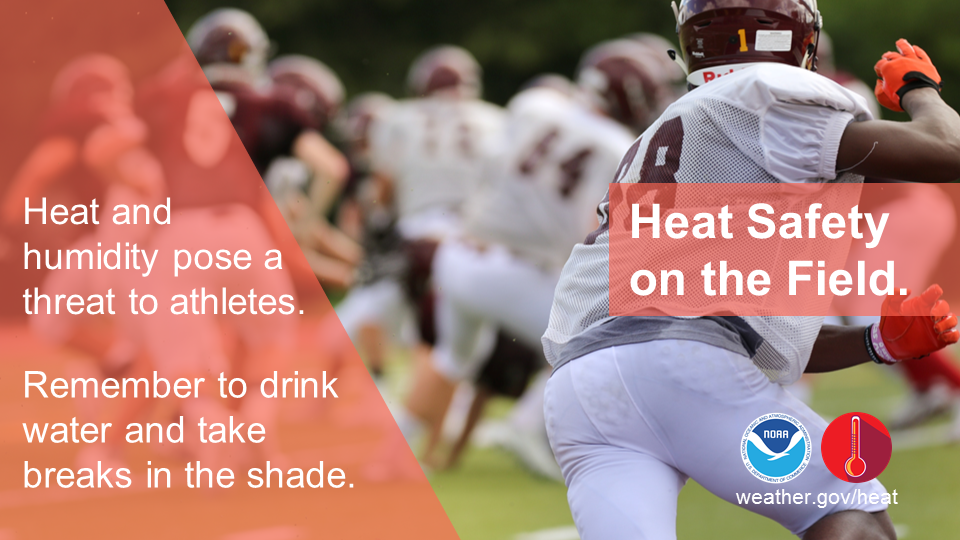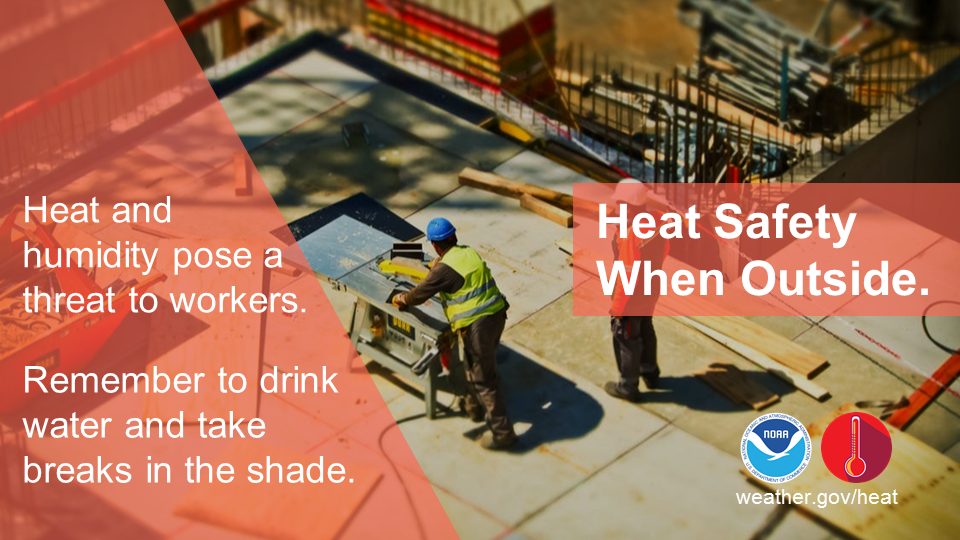Please help the National Weather Service spread these important safety messages on social media! Everyone is welcome to use the text and images provided below to help the NWS build a Weather-Ready Nation.
Facebook
Did you know that cities could be 7 degrees F warmer than neighboring grassy areas, such as farms or parks? #HeatScience https://earthobservatory.nasa.gov/eokids/pdf/EOKids_201701_UHI.pdf
Twitter
Did you know that cities could be 7 degrees F warmer than neighboring grassy areas, such as farms or parks? #HeatScience https://earthobservatory.nasa.gov/eokids/pdf/EOKids_201701_UHI.pdf

Facebook
Heat is typically the leading cause of weather-related fatalities each year. A heat wave is a period of abnormally hot and humid weather, generally lasting more than two days. Heat waves have the potential to cover a large area, exposing a high number of people to a hazardous combination of heat and humidity, which can be very taxing on the body. Learn how to stay safe during a heat wave at www.weather.gov/heatsafety #KeepYourCool #HeatSafety
Twitter
Heat wave: a period of abnormally hot & humid weather, lasting 2+ days. #KeepYourCool www.weather.gov/heat #HeatSafety

Facebook
Protect yourself from the heat while working or playing outside. Drink plenty of water to stay hydrated and apply sunscreen regularly. Also, dress in lightweight and light-colored clothing and wear a wide brimmed hat. www.weather.gov/heatsafety #KeepYourCool #HeatSafety
Twitter
Protect yourself from the heat while working or playing outside. www.weather.gov/heatsafety #KeepYourCool #HeatSafety

Facebook
Outdoor workers can be at a higher risk from the effects of excessive heat. When working under hot conditions, OSHA recommends #WaterRestShade as well as allowing more frequent breaks for new workers or workers who have been away from the job for a week or more (acclimatization). Knowing symptoms, prevention and emergency response methods can help prevent heat-related illnesses and death. Check weather forecasts ahead of time to be better prepared. www.osha.gov/heat #OSHA #HeatSafety
Twitter
Working outside in the #heat today? Make sure you get #WaterRestShade! Learn more at www.osha.gov/heat #OSHA #HeatSafety

Facebook
Heat is typically the leading cause of weather-related fatalities each year. Heat waves have the potential to cover a large area, exposing a high number of people to a hazardous combination of heat and humidity, which can be very taxing on the body. Learn how to stay safe during a heat wave at www.weather.gov/heat #KeepYourCool #HeatSafety
Twitter
Heat wave: a period of abnormally hot & humid weather, lasting 2+ days. #KeepYourCool www.weather.gov/heat #HeatSafety

Facebook
Never leave children, disabled or elderly adults or pets in parked vehicles. Studies have shown that the temperature inside a parked vehicle can rapidly rise to a dangerous level for children, pets and even adults. Leaving the windows slightly open does not significantly decrease the heating rate. The effects can be more severe on children because their bodies have not developed the ability to efficiently regulate internal temperature. weather.gov/safety/heat-children-pets #HeatSafety #LookBeforeYouLock
Twitter
Never leave children, disabled adults or pets in parked vehicles. weather.gov/safety/heat-children-pets #LookBeforeYouLock

Facebook
Spending time in the sun on vacation this summer? Apply plenty of sunscreen! Also keep in mind that heat-related illness is a possibility if you don’t take certain precautions. Find out more about heat-related illnesses and how to prevent them at www.weather.gov/heat #HeatSafety #SpringSafety
Twitter
Spending time in the sun? Apply sunscreen and avoid heat related illness: www.weather.gov/heat #HeatSafety #SpringSafety

Facebook
Stay safe in the heat! Limit outdoor activities. Drink plenty of water and avoid alcohol. Wear light-colored clothing and sunscreen. Work outdoors early or very late in the day. www.weather.gov/heatsafety #HeatSafety #KeepYourCool
Twitter
Stay safe in the heat! Learn more at www.weather.gov/heatsafety #HeatSafety #KeepYourCool

Facebook
Four questions to ask yourself before working outdoors: Do you have enough water? Do you have temporary shade available? Do you know the symptoms of heat illness? Do you know who to call in an emergency? www.weather.gov/heatsafety www.osha.gov/heat #HeatSafety #KeepYourCool
Twitter
Learn the four questions to ask before working outdoors. www.osha.gov/heat #HeatSafety #KeepYourCool

Facebook
When it is hot, wear lightweight, loose-fitting, light-colored clothing to reflect heat and sunlight. Hats are also a good idea to protect your face and scalp from harmful UV rays if you will be spending time directly in the sunshine. Apply sunscreen liberally. www.weather.gov/heatsafety #HeatSafety #KeepYourCool
Twitter
Find out how to dress for the weather www.weather.gov/heatsafety #HeatSafety #KeepYourCool

Facebook
During extremely hot and humid weather, your body's ability to cool itself is challenged. When the body heats too rapidly to cool itself properly, or when too much fluid or salt is lost through dehydration or sweating, the body temperature will rise. As a result, you or someone you care about may experience a heat-related illness. Learn the symptoms of excessive heat exposure and the appropriate responses. weather.gov/safety/heat-illness #HeatSafety
Twitter
Learn the symptoms of excessive heat exposure and the appropriate responses.
weather.gov/safety/heat-illness #HeatSafety

Facebook
Did you know the air temperature can actually feel hotter than what the thermometer reads? The Heat Index is a measure of how hot it really feels when relative humidity is factored in. This measurement is based on being in the shade, so it’s actually hotter directly in the sun. Find out what the Heat Index is by using the NWS Index chart below or the Heat Index calculator found at: weather.gov/safety/heat-index #HeatSafety #SpringSafety
Twitter
The Heat Index tells you how hot it feels with humidity weather.gov/safety/heat-index #HeatSafety #SpringSafety
